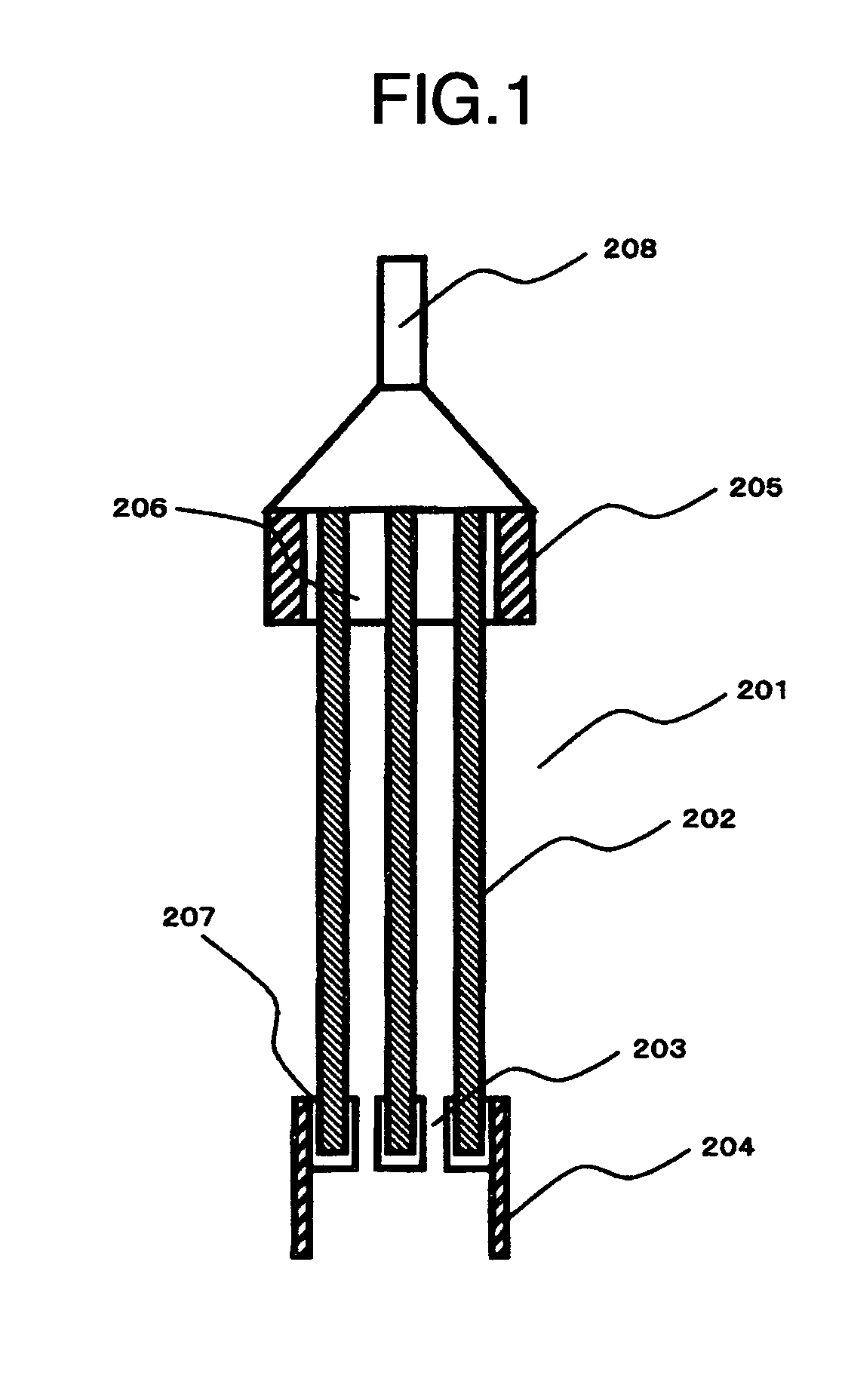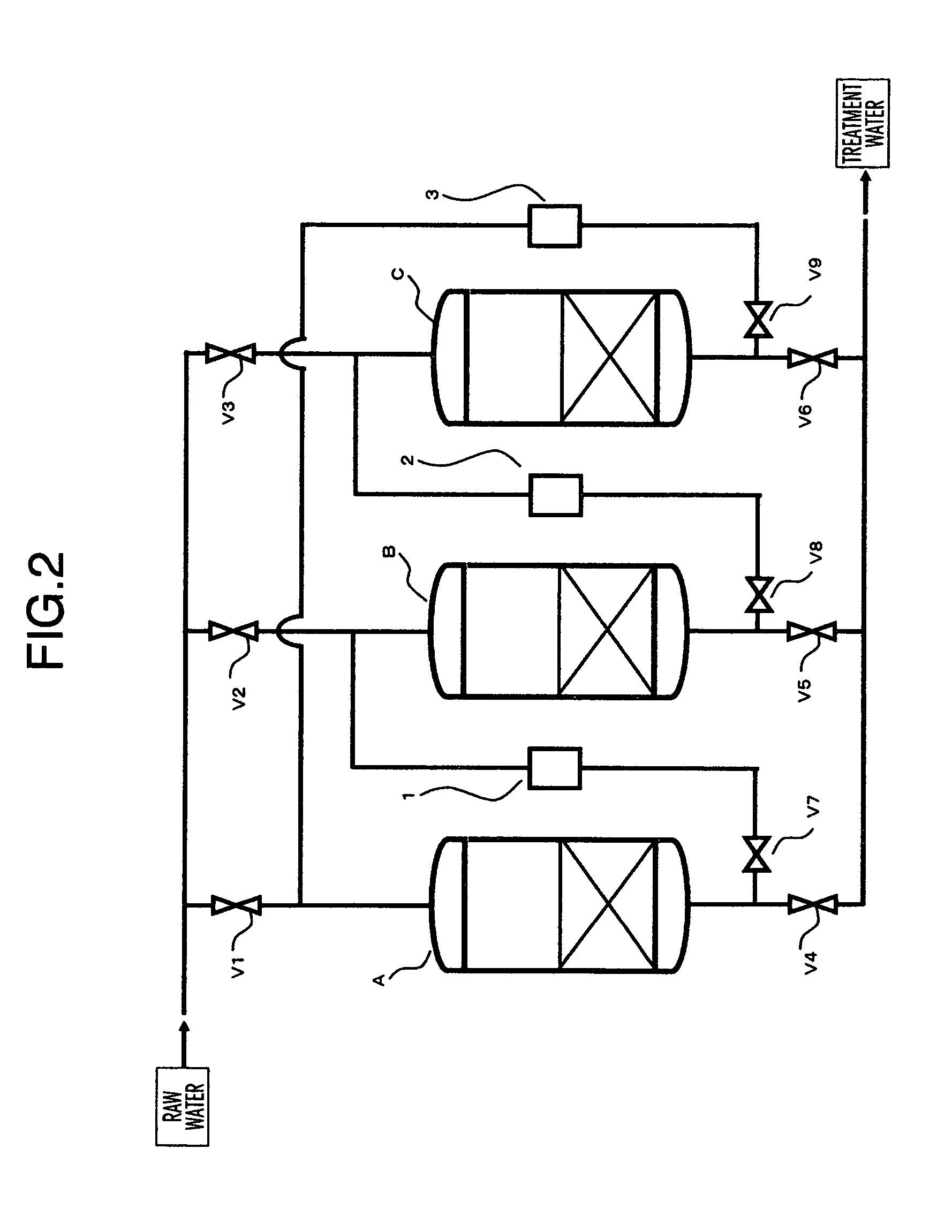Apparatus for water treatment and method of treating water
a technology of apparatus and water treatment, applied in water/sewage treatment by ion exchange, chemical/physical processes, nuclear engineering, etc., can solve the problems of increasing the concentration of phosphor in the treatment water, requiring regeneration of adsorbent, and increasing the amount of sludge generated, so as to reduce and remove a specific ion efficiently and low cost
- Summary
- Abstract
- Description
- Claims
- Application Information
AI Technical Summary
Benefits of technology
Problems solved by technology
Method used
Image
Examples
production example 1
Production-1 of Inorganic Ion Adsorbing Material
[0282]1 L of 0.15 mol aqueous solution of zirconium oxychloride (ZrOCl2) was prepared. The solution contained metallic ions of 13.7 g as zirconium. Ferrous sulfate crystal (FeSO4 / 7H2O) in an amount of 84.0 g was added and dissolved into the aqueous solution which was being stirred. The amount of added ferrous sulfate corresponds to 0.3 mol of ferrous ions (F / T (molar ratio): 0.67).
[0283]Next, 15% by weight of a sodium hydroxide solution was added dropwise to the aqueous solution which was being stirred, till the pH of the solution reached 9, and then a bluish green precipitate was produced. Subsequently, air in an amount of 10 L / hour was blown into the aqueous solution while heating to 50° C. When air is continuously blown into the solution, the pH of the aqueous solution decreases. In this case, the 15% by weight of sodium hydroxide solution was added dropwise into the aqueous solution to keep it to pH of 8.5 to 9. After air had been ...
production example 2
Production-1 of Porous Formed Article
[0285]Ethylene-vinylalcohol copolymer (EVOH, Nippon Synthetic Chemical Industry Co., Ltd., Soarnol E3803 (trade name) in an amount of 10 g, polyvinylpyrrolidone (PVP, BASF Japan Co., Ltd., Luvitec K30 Powder (trade name) in an amount of 10 g and dimethylsulfoxide (DMSO, Kanto Chemical Co., Ltd.) in an amount of 80 g were dissolved in water heated to 60° C. in a separable flask to obtain a homogenous polymer solution.
[0286]Into the polymer solution in an amount of 100 g, the powder of the inorganic ion adsorbing material in an amount of 92 g produced in Production Example 1 was added, and the mixture was adequately mixed to form slurry. The obtained slurry mixture was heated to 40° C. and supplied into a cylindrical rotating vessel having a nozzle with a diameter of 5 mm opened on the side face. Then, the vessel was rotated to form a droplet through the nozzle by a centrifugal force (15G), and the droplet was discharged into a solidification bath ...
production example 3
Production-2 of Inorganic Ion Adsorbing Material
[0290]Zirconium hydroxide (Doral-ZOH100 (trade name) made by Doral Company (Australia)) was dried at 70° C. at atmospheric pressure. The dried zirconium hydroxide was pulverized in a ball mill for eight hours to obtain the white powder of the hydrated zirconium dioxide with an average particle diameter of 3.7 μm. The BET specific surface area of the powder was 344 m2 / g.
PUM
| Property | Measurement | Unit |
|---|---|---|
| concentration | aaaaa | aaaaa |
| diameter | aaaaa | aaaaa |
| diameter | aaaaa | aaaaa |
Abstract
Description
Claims
Application Information
 Login to View More
Login to View More - R&D
- Intellectual Property
- Life Sciences
- Materials
- Tech Scout
- Unparalleled Data Quality
- Higher Quality Content
- 60% Fewer Hallucinations
Browse by: Latest US Patents, China's latest patents, Technical Efficacy Thesaurus, Application Domain, Technology Topic, Popular Technical Reports.
© 2025 PatSnap. All rights reserved.Legal|Privacy policy|Modern Slavery Act Transparency Statement|Sitemap|About US| Contact US: help@patsnap.com



